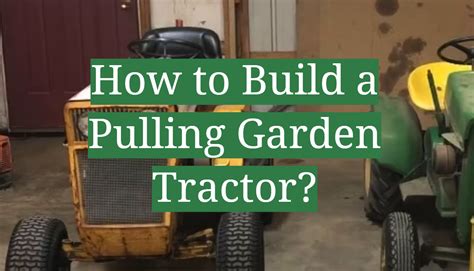Get the Edge: Build a Superior Pulling Garden Tractor
Garden tractors are versatile machines, but some owners crave more power and performance, particularly for demanding tasks like pulling heavy loads or working challenging terrain. Building a superior pulling garden tractor involves careful consideration of several key components and modifications. This isn't about simply bolting on parts; it's about optimizing the entire system for maximum pulling power and durability. This guide will walk you through the essential steps to transform your garden tractor into a pulling powerhouse.
What Makes a Garden Tractor Ideal for Pulling?
Before diving into modifications, understanding the fundamentals of pulling performance is crucial. Key factors include:
- Engine Power and Torque: A high-torque engine is paramount for pulling. Torque is the twisting force that moves a load. While horsepower is important, a high torque rating at lower RPMs is key for sustained pulling power.
- Transmission: A strong and robust transmission capable of handling high loads is crucial. Look for gear ratios that provide ample low-end torque for pulling heavy implements. Consider upgrading to a heavier-duty transmission if necessary.
- Tires and Weight: Larger, heavier tires with aggressive tread patterns provide better traction, especially on uneven ground or in slippery conditions. Adding weight to the tractor increases traction and stability when pulling heavy loads. Wheel weights or a ballast box are common additions.
- Frame and Axle Strength: A sturdy frame and axles are essential to withstand the stress of pulling heavy loads. Reinforcements might be necessary depending on the tractor's original design and the intended pulling tasks.
- Hitch System: A strong and properly adjusted hitch system is critical for efficient pulling. Ensure your hitch is rated for the weight you intend to pull.
Choosing the Right Garden Tractor for Modification
Not all garden tractors are created equal. For pulling applications, consider these factors when selecting a base model:
- Size and Weight: A larger, heavier tractor will naturally provide a more stable and powerful pulling platform.
- Engine Type: Diesel engines generally offer more torque than gasoline engines, making them ideal for heavy pulling work.
- Existing Features: Consider features like a three-point hitch, which simplifies the attachment of pulling implements.
H2: Common Modifications for Superior Pulling Performance
Now let's dive into the specific modifications that can elevate your garden tractor's pulling capabilities:
H3: Engine Upgrades
While a complete engine swap is a significant undertaking, consider options like:
- Performance Air Filter: Improves airflow for better combustion and increased power.
- Performance Exhaust: Reduces backpressure, leading to increased engine efficiency.
- ECU Tuning (if applicable): Optimizing the engine's computer control unit (ECU) can enhance performance but requires specialized knowledge and tools. This is often not feasible with older models.
Important Note: Always consult your owner's manual and ensure any engine modifications are compatible with your tractor's specifications. Incorrect modifications can damage your engine.
H3: Transmission and Drivetrain Upgrades
- Gear Ratio Changes: Modifying gear ratios (if possible) can provide more pulling power at lower speeds. This often involves replacing gears within the transmission, requiring significant mechanical expertise.
- Differential Lock (if applicable): A differential lock prevents wheel slippage, particularly beneficial on uneven terrain or when pulling heavy loads.
H3: Enhancing Traction and Stability
- Weight Addition: Adding weight is arguably the simplest and most effective way to improve traction. Wheel weights, a ballast box, or even filling tires with fluid are common techniques.
- Tire Upgrades: Larger, heavier-duty tires with aggressive tread patterns significantly increase traction.
H3: Reinforcing the Frame and Axles
- Structural Reinforcement: Inspect the frame and axles for any signs of weakness. Welding additional bracing or using aftermarket reinforcement kits can strengthen the tractor's structure to handle the increased stress of heavy pulling.
H3: Upgrading the Hitch System
- Heavy-Duty Hitch: A heavy-duty hitch with a higher weight rating is essential for safe and efficient pulling. Ensure the hitch is properly adjusted and securely attached to the tractor.
Safety Precautions: A Critical Consideration
Modifying your garden tractor for pulling involves inherent risks. Always prioritize safety:
- Thorough Inspection: Carefully inspect all components before and after modifications.
- Proper Maintenance: Regular maintenance is crucial to ensure the tractor's safe and reliable operation.
- Wear Protective Gear: Always wear appropriate safety gear, including eye protection, gloves, and sturdy footwear.
- Start Small: Gradually increase the load to test the tractor's capabilities and ensure everything is working as expected.
- Seek Professional Help: If you lack the necessary mechanical skills, seek assistance from a qualified mechanic.
Building a superior pulling garden tractor requires careful planning, execution, and a commitment to safety. By following these guidelines, you can transform your garden tractor into a reliable and powerful machine capable of tackling even the most demanding pulling tasks. Remember, safety should always be your top priority.

